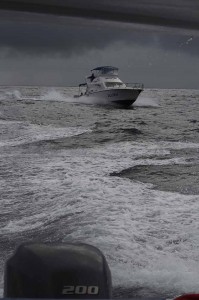 Welcome to our blog for the Plastic in the Pacific Crusade. If you missed the earlier editions please go to category file in the footer to go back and read them. They are listed under Plastic in the Pacific. Over the coming year we will be writing regularly of our adventures and what we are seeing. In this article we write about our trip to Isla Isabela
Welcome to our blog for the Plastic in the Pacific Crusade. If you missed the earlier editions please go to category file in the footer to go back and read them. They are listed under Plastic in the Pacific. Over the coming year we will be writing regularly of our adventures and what we are seeing. In this article we write about our trip to Isla Isabela
With a few days off diving, we wanted to take the opportunity to get over to Isla Isabela and explore as we had been told it is very different to Santa Cruz. A lot of people who have worked with me or sailed with me, know I have a saying, ‘it’s amazing, it’s special, it’s unique’ Well in this case it rings so true.
Our transfer was to be on one of these 12m fly bridge cruisers with a couple of outboards bolted on the back. I wasn’t looking forward to the 2 hour journey which would be into the waves and on the morning it was reasonably windy. We went ashore and had our bags checked and sealed. They are so careful not to introduce species between islands that they check everyone’s bags. One surprising thing is they use a single use plastic tie to seal the bag. If they had a reusable one they would save a lot of waste. We boarded the long boat and then jumped aboard Gabi. It wasn’t a fly bridge version, just a single level and to this day I will never know how the skipper could see out of the windows in a sea way. The window would constantly be covered spray.
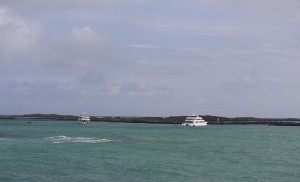 The trip was not enjoyable at all. We launched off the top of waves, the starboard outboard would cavitate a lot so the skipper would have to pull the revs back to engage the prop again and there was no breeze in the cabin, we were dry but I was hot and sweaty for most of the trip. So when we arrive in the smooth waters off Isabela we were very relieved. The anchorage for bigger boats is tucked in behind some rocks. It’s got a small roll that will come through but it is a nicer anchorage than Puerto Ayora. Better still you could actually jump off the back of your boat here. But you are a long way out from the jetty as the reef extends a fair way. With a stern anchor, you could set up here nicely. Probably wouldn’t have the slime growth on the hull issues of Puerto Ayora either as the water is a lot cleaner.
The trip was not enjoyable at all. We launched off the top of waves, the starboard outboard would cavitate a lot so the skipper would have to pull the revs back to engage the prop again and there was no breeze in the cabin, we were dry but I was hot and sweaty for most of the trip. So when we arrive in the smooth waters off Isabela we were very relieved. The anchorage for bigger boats is tucked in behind some rocks. It’s got a small roll that will come through but it is a nicer anchorage than Puerto Ayora. Better still you could actually jump off the back of your boat here. But you are a long way out from the jetty as the reef extends a fair way. With a stern anchor, you could set up here nicely. Probably wouldn’t have the slime growth on the hull issues of Puerto Ayora either as the water is a lot cleaner.
We transfer ashore and have to pay US$5 for using the jetty. They get you everywhere it seems. Then we get taken off to our hotel by the owner in his ute. It seems on Isabela you can have any car, as long as it is a dual cab Chevy D-Max. Every car is a dual cab ute and we saw one van/bus. Must be good deals going. We stayed at the Coral Blanco Hotel. It was basic and at US$30 per night it is a good price. Don’t expect too many luxuries but it had a bed and a bathroom along with air conditioning so it did the job for us. There are some really nice resorts here if you want to spend the money but we just needed a bed to sleep in, our days would be filled with activities for the few days we were here.
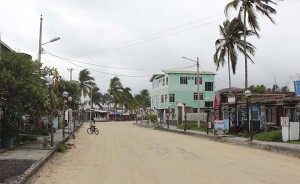 Once we checked in we went for a stroll down the main street. It is a sand street and kids are riding bikes without helmets and cars go slow enough to ensure you can walk down the middle of the street without being run over. It really is a sleepy beachside town and it had a great feel to it. It’s only about 1km long and the restaurant sector is about 100m long at best. We got a few supplies from the corner shop and put them in the fridge in our room. Then it was off to the tortoise sanctuary which also takes in a few lakes where you can see pink flamingos. Dodging the marine iguanas at the start of the board walk, we walked along for about 5 minutes before we ran into our first flamingos. They are simply the most stunning pink that you will ever see on a bird. I never thought a bird could be this color. Annika was in her element with such a beautiful bird to capture with her camera.
Once we checked in we went for a stroll down the main street. It is a sand street and kids are riding bikes without helmets and cars go slow enough to ensure you can walk down the middle of the street without being run over. It really is a sleepy beachside town and it had a great feel to it. It’s only about 1km long and the restaurant sector is about 100m long at best. We got a few supplies from the corner shop and put them in the fridge in our room. Then it was off to the tortoise sanctuary which also takes in a few lakes where you can see pink flamingos. Dodging the marine iguanas at the start of the board walk, we walked along for about 5 minutes before we ran into our first flamingos. They are simply the most stunning pink that you will ever see on a bird. I never thought a bird could be this color. Annika was in her element with such a beautiful bird to capture with her camera.
The walk is about 1.2kms to the tortoise sanctuary and it is a unique walk in that the vegetation is so varied and at times sparse, other times lush. The tortoise sanctuary is much better than Santa Cruz and they have lots more turtles of different sizes. The small ones were very cute. There must have been over 300 tortoises in the sanctuary. It made us wonder when they get released into the wild. We had been told a few hundred meters past the sanctuary on the main road is an old quarry that is filling with water and is the best spot to see Flamingos. We got there to find 9 more of these amazing beautiful birds wading in the waters whilst feeding.
We walked back and made our way to the beach where we walked along the rocks. Then I saw a blemish in the rocks. In amongst the black volcanic rocks was some white. It wasn’t boobie bird poo, this was moving. It was a tropical penguin, our first sighting. Then we saw a few more swimming in the water as the sea lions frolicked in the waves and the pelicans bombarded the water in a feeding frenzy. Nature was in full force here and we felt very fortunate to be able to experience this.
Dinner was at a restaurant in town and with Annika’s allergies it is always hard to find a place to eat. Being gluten free, if they cook pizza in the kitchen, it usually means flour is everywhere so Annika won’t eat there. But we had no option, every place cooked pizza. The only place that didn’t was closed for the day. So Annika was very nervous but the friendly waiter was awesome and spoke very good English. He kept saying to Annika ‘it will be okay, don’t worry’ and when she had her meal in front of her it was all good. I had the most delicious seafood risotto I’ve had in a long time. The place was called El Valero. We chose it because ‘Valero’ is Spanish for ‘Yacht’. Sleeping on land was very different that night in a double bed that neither of us really fitted in but we’d make do.
In the morning we had our complimentary breakfast at El Faro restaurant and then we got picked up from there to go on our Volcano walk. Sierra Negra is just one of the 6 volcanos that make up Isabela, the largest island in the Galapagos. The most recent eruption was in the north on Wolf Volcano just 6 months prior and Sierra Negra’s most recent eruption was just 10 years ago in 2005. In fact the Galapagos are so active still that islands come and go over centuries so what we saw on our trip, is not what future generations will see, and that’s pretty unique.
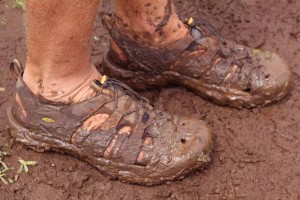 We had been told that the walk was 16kms and that it was muddy and slippery so take the gumboots offered even at the US$3 charge. So Annika did. They looked at my feet (Size 14/EU48) and laughed. Ecuador doesn’t have gumboots that big they said. So I’d stick it out with my Keen walkers. I’d chosen them for the day as I had a feeling I’d have this problem and if mud got in them it didn’t matter, I’d clean them out when I got to the beach. And they were certainly sturdy enough for the walk. We got taken to the bottom of the walk in our ute and it was misty and cloudy. We adorned our rain jackets and off we went. At first I thought the track wasn’t so bad and that people had talked it up a little but before you knew it, people were struggling to walk in the mud as the gumboots got stuck. It was kind of fun for the first bit but after a while it was hard work, especially for two people who hadn’t been walking so much of late.
We had been told that the walk was 16kms and that it was muddy and slippery so take the gumboots offered even at the US$3 charge. So Annika did. They looked at my feet (Size 14/EU48) and laughed. Ecuador doesn’t have gumboots that big they said. So I’d stick it out with my Keen walkers. I’d chosen them for the day as I had a feeling I’d have this problem and if mud got in them it didn’t matter, I’d clean them out when I got to the beach. And they were certainly sturdy enough for the walk. We got taken to the bottom of the walk in our ute and it was misty and cloudy. We adorned our rain jackets and off we went. At first I thought the track wasn’t so bad and that people had talked it up a little but before you knew it, people were struggling to walk in the mud as the gumboots got stuck. It was kind of fun for the first bit but after a while it was hard work, especially for two people who hadn’t been walking so much of late.
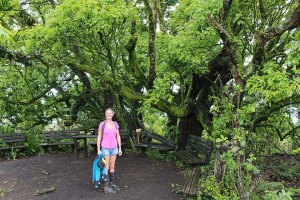 Along the ridge of the volcano and the track dried up a bit so people could change into walkers if they desired. The crater was clouded in so we continued along our path. At the top, the lookout to the north was starting to show signs that the clouds were breaking. We headed on down the north face and came across this stunning huge tree. It was covered in moss and it really was quite a special tree. I usually don’t think much of trees but this was pretty cool. Then as we descended further the clouds cleared and the view was spectacular to say the least. On the south side of the volcano (windward side) it was lush green and wet, on the north side it was completely opposite. It was like a moonscape with very little vegetation, recent lava flows (well 10-20 years old is pretty recent for a volcano) created different colors in the rocks with the older ones being red and the newer black. Hopefully the photos do it justice as I’m struggling to find the words right now. It was special, it was amazing and it was unique…in every way.
Along the ridge of the volcano and the track dried up a bit so people could change into walkers if they desired. The crater was clouded in so we continued along our path. At the top, the lookout to the north was starting to show signs that the clouds were breaking. We headed on down the north face and came across this stunning huge tree. It was covered in moss and it really was quite a special tree. I usually don’t think much of trees but this was pretty cool. Then as we descended further the clouds cleared and the view was spectacular to say the least. On the south side of the volcano (windward side) it was lush green and wet, on the north side it was completely opposite. It was like a moonscape with very little vegetation, recent lava flows (well 10-20 years old is pretty recent for a volcano) created different colors in the rocks with the older ones being red and the newer black. Hopefully the photos do it justice as I’m struggling to find the words right now. It was special, it was amazing and it was unique…in every way.
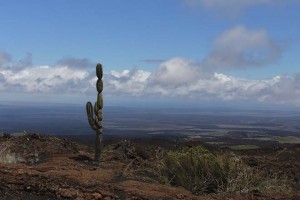 We walked out along the rocks and in several spots we were told to feel the heat still generating from this active volcano. There were collapsed lava tunnels and occasionally out of the blue a cactus would rise up on its own. At the end of the walk we sat down and looked out over the view north which took in the coast both east and west, the lava flows making it to the coast and hidden amongst the clouds further north were the bigger volcanos of the island. This little part was called Chico Volcano. It didn’t have a crater, it was out the side of Sierra Negra. It was one of the most stunning places I have ever been and I kept comparing it to Mount Haleakala in Maui, Hawaii, the volcano I had climbed many times previously. But this was very different to that.
We walked out along the rocks and in several spots we were told to feel the heat still generating from this active volcano. There were collapsed lava tunnels and occasionally out of the blue a cactus would rise up on its own. At the end of the walk we sat down and looked out over the view north which took in the coast both east and west, the lava flows making it to the coast and hidden amongst the clouds further north were the bigger volcanos of the island. This little part was called Chico Volcano. It didn’t have a crater, it was out the side of Sierra Negra. It was one of the most stunning places I have ever been and I kept comparing it to Mount Haleakala in Maui, Hawaii, the volcano I had climbed many times previously. But this was very different to that.
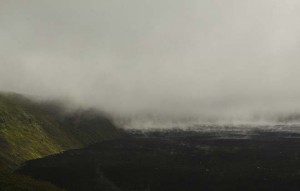 On the walk back along the 8km trail we got back to the top of the crater rim and the clouds had cleared enough to see the crater. Seeing steam coming from the lava proved how recent the last eruption had been. Again, very hard to describe in words but Annika’s picture should tell the story quite nicely. We made our way back down the mountain to our car and made our way back to the hotel. We were fairly exhausted by this stage but went for a swim in the ocean, mainly to clean my shoes that had done their job nicely. So stoked to have the support of Keen for this campaign. Any support is greatly appreciated but their shoes were a perfect fit for us, pardon the pun.
On the walk back along the 8km trail we got back to the top of the crater rim and the clouds had cleared enough to see the crater. Seeing steam coming from the lava proved how recent the last eruption had been. Again, very hard to describe in words but Annika’s picture should tell the story quite nicely. We made our way back down the mountain to our car and made our way back to the hotel. We were fairly exhausted by this stage but went for a swim in the ocean, mainly to clean my shoes that had done their job nicely. So stoked to have the support of Keen for this campaign. Any support is greatly appreciated but their shoes were a perfect fit for us, pardon the pun.
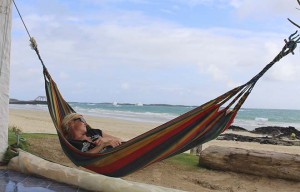 So there we are on a white sandy beach, swimming in the surf and just 10m away about 15 tropical penguins swim past. We’re pinching ourselves to make sure this was real. Wow, swimming with tropical penguins, can’t do that in too many places in the world. Pity we didn’t have our cameras. We then found a hammock at one of the bars and relaxed for the afternoon, although Annika was chomping at the bit to get back and edit her photos of the day. We considered hiring bikes to go out to the wall of tears which was 5kms away but we were too tired from our walk to even consider that. In the evening we ate at Jim and Marlena’s ‘The Booby Trap.’ Jim is American and had commented on one of our facebook posts so it was good to catch up with him and talk environmental issues. He regularly cleans up the beach between his home and his restaurant. It was great food too and Marlena catered for Annika nicely.
So there we are on a white sandy beach, swimming in the surf and just 10m away about 15 tropical penguins swim past. We’re pinching ourselves to make sure this was real. Wow, swimming with tropical penguins, can’t do that in too many places in the world. Pity we didn’t have our cameras. We then found a hammock at one of the bars and relaxed for the afternoon, although Annika was chomping at the bit to get back and edit her photos of the day. We considered hiring bikes to go out to the wall of tears which was 5kms away but we were too tired from our walk to even consider that. In the evening we ate at Jim and Marlena’s ‘The Booby Trap.’ Jim is American and had commented on one of our facebook posts so it was good to catch up with him and talk environmental issues. He regularly cleans up the beach between his home and his restaurant. It was great food too and Marlena catered for Annika nicely.
Isla Isabella has three big tours. The volcano, the Tunnels and Las Tintoreras. Tintoreras is just out the front and a snorkel and walk which you need a guide for. We had been told the Tunnels was a much better option so the following morning we boarded a speed boat and bounced our way for 45 minutes to the southern end of the island. Due to tide we would snorkel at two different places and then go and see the tunnels. We had heard good things about this snorkel but what we saw we did not expect. It is a guided snorkel so you follow your guide. He says on the boat that the sharks ore one way, the turtles another and the sea horses another. Sounds pretty simple but my way of thinking was that marine creatures aren’t that predictable. But I am happy to say I’m wrong. In the caves where he said they were, several white tip sharks where resting up. A few of them were swimming around as they got disturbed by the ‘Snorkel Racer’ a lady who thought snorkelling was a race until I told her she was scaring everything and to stop. As soon as she stopped, a giant turtle swims up to her. Seriously I think I have been a turtle in a previous life.
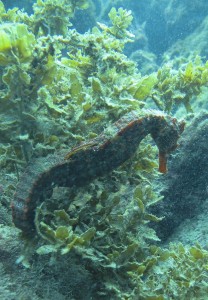 After the sharks we continue towards the turtles and I am joined by a huge turtle. I am filming him and his head is huge. He’s just happy chomping away at the algae’s on the rocks and I get Annika’s attention and she comes over. We spend 5 minutes with him and he doesn’t care for our presence at all. It’s only when others joined us that he decided to swim off. Next on the agenda were sea horses. I’ve never seen a sea horse in the wild. Annika has only seen pygmy sea horses and we were on the hunt for the pacific sea horse that grows up to 10cm in length. So we swim to the mangroves which is very strange for us Australian’s. In Australia you don’t swim in mangroves as crocs and jellies exist in them so not a good idea. But over in the mangroves our guide points out a sea horse. WOW. He was hanging onto a stick and just flowing in the current. They really are a special creature.
After the sharks we continue towards the turtles and I am joined by a huge turtle. I am filming him and his head is huge. He’s just happy chomping away at the algae’s on the rocks and I get Annika’s attention and she comes over. We spend 5 minutes with him and he doesn’t care for our presence at all. It’s only when others joined us that he decided to swim off. Next on the agenda were sea horses. I’ve never seen a sea horse in the wild. Annika has only seen pygmy sea horses and we were on the hunt for the pacific sea horse that grows up to 10cm in length. So we swim to the mangroves which is very strange for us Australian’s. In Australia you don’t swim in mangroves as crocs and jellies exist in them so not a good idea. But over in the mangroves our guide points out a sea horse. WOW. He was hanging onto a stick and just flowing in the current. They really are a special creature.
I was so lost in the sea horse and getting good video, I lost the group. I thought they had gone back to the boat so I started making my way back. Then I see that odd white amongst the rocks again. Tropical penguins on the rocks. I swam up to them slowly and there I was, alone in the water just 50cm from two tropical penguins that were happily cleaning themselves. People on our boat had seen what I was up to and came and joined me, as did Annika and the guide. Before you knew it there were so many people around but the two penguins continued to just preen themselves. We eventually left as the guide said we needed to move to the next place. Just after we got back on the boat a sea lion joined the penguins and one of the penguins went for a swim. Pity we missed that, I really wanted to see a penguin in the water swimming.
We took off for another 15 minutes to our next snorkel spot. It was a rocky outcrop and there were penguins and blue footed boobies all over the rocks, along with sea lions. The boobies disappeared pretty quickly as did the sea lions but the penguins stayed. Annika saw a couple swimming but I missed them. I was too focused on a pregnant sea horse that was down about 4m. I tried to leave the GoPro filming at the 4m depth but every time I set it up, the damsels would attack it and knock it out of place. I did get some footage of it eventually.
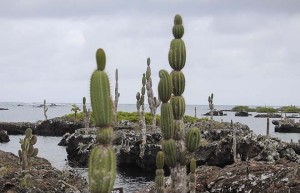 Back on the boat and I was realizing that this had been the best day of snorkeling I’ve ever had. So much variety and the mega fauna you want to see in the Galapagos. But our day wasn’t over yet. We then cruised on our speed boat into this maze of volcanic rock that formed tunnels. The water was pristine and we tied up along one wall and went for a walk on this unique landscape. We’ve been to some pretty awesome places in the world but this was arguably the most unique and beautiful place I’ve ever been. A couple of turtles just swam past to add to the aura and in another spot two sea lions were frolicking. On the rocks we found our blue footed boobie birds. Their feet are a stunning color that you just can’t imagine on a bird.
Back on the boat and I was realizing that this had been the best day of snorkeling I’ve ever had. So much variety and the mega fauna you want to see in the Galapagos. But our day wasn’t over yet. We then cruised on our speed boat into this maze of volcanic rock that formed tunnels. The water was pristine and we tied up along one wall and went for a walk on this unique landscape. We’ve been to some pretty awesome places in the world but this was arguably the most unique and beautiful place I’ve ever been. A couple of turtles just swam past to add to the aura and in another spot two sea lions were frolicking. On the rocks we found our blue footed boobie birds. Their feet are a stunning color that you just can’t imagine on a bird.
The day was truly spectacular but unfortunately we had to leave as our transfer back to Santa Cruz was that afternoon. I wasn’t looking forward to the trip however when we checked in, we left straight away as there were only three passengers so we could stretch out and relax all the way back to our baby sitting in Puerto Ayora. The trip was a bit smoother as we were slightly downwind but still not what I would call pleasant, but the pain had been worth it. Isabela is a very special place. Being active people I am not sure we would want to spend more than a week there as we had completed most activities in the few days we had been there.
For the cruisers out there, be aware that they won’t let you go back to a port you have previously visited and with no fuel and very little provisions on this island, whilst it is the most western island to possibly depart for the Marquesas, I would suggest that if you get the autograph, that you go from San Cristobal, to Isabella and then back to Santa Cruz as you want to spend your final days in Santa Cruz, they have all the facilities for cruising yachts and for provisioning a boat for a long journey there.
So to sum up Isla Isabella, it is special, it is amazing and it is unique but more importantly….it is spectacular. It is a place we will never forget and if you ever get a chance, you have to get to this place and do the two tours we did.
In our next edition we return to Santa Cruz for our final days in Galapagos as we prepare to head west to the Marquesas Islands.
Ocean Crusaders are out to change the way people treat our oceans. Our online education program is free to download at www.OceanCrusaders.org/education where children can learn of the issues our oceans are facing and how they can make a difference. The Plastic in the Pacific Crusade is about educating the South Pacific Islands, finding out what is happening in these islands and updating our programs. You can join us in the Pacific and see for yourself what we do.
Ocean Crusaders Plastic in the Pacific Crusade is proudly supported by: Cressi Dive Gear, Gill Marine, Keen Footwear Australia, Barz Optics Sunglasses, Maxsea Navigation Software, Digital Diver Cairns, LED Dive Lights Australia, Boat Names Australia, Predictwind Weather & Sail-world.com
WWW.OCEANCRUSADERS.ORG
[cincopa AgMALI9MTTCT]
SIGN UP FOR OUR BLOGS